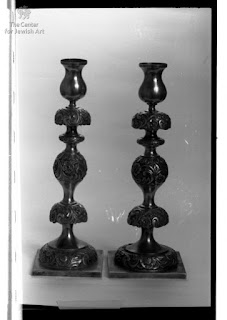Justo Sierra Historical Synagogue, Mexico City
_________________________________________________________________________________________________________________________________________________ "It is not in the heavens, that you should say, "Who among us can go up to the heavens and get it for us and impart it to us, that we may observe it?" (...) No, the thing is very close to you, in your mouth and in your heart, to observe it". Deuteronomy
31 de outubro de 2017
30 de outubro de 2017
29 de outubro de 2017
26 de outubro de 2017
25 de outubro de 2017
24 de outubro de 2017
23 de outubro de 2017
Mohamed Helmy
Later this week, Yad Vashem will for the first time recognize
an Arab, Dr. Mohamed Helmy, as a Righteous Among the Nations for saving
the lives of four of his Jewish friends in the Holocaust. An Egyptian urologist who moved to Berlin in 1922, Dr. Helmy was
working for the Robert Koch Institute, but was fired in 1937 for being
non-Aryan. He was arrested by the Nazis, but was released shortly
thereafter and allowed to return to his home. When the Nazis began
deporting Berlin’s Jews, Dr. Helmy hid Anna Boros, a 21-year-old family
friend, in his cabin in the city’s Buch neighborhood, where she assumed a
false identity, pretended to be married to a Muslim man, and wore a
hijab. Dr. Helmy also helped hide Boros’s mother Julie, her stepfather
Gerog Wehr, and her grandmother, Cecilie Rudnik, and was himself nearly
caught after the family was discovered and tortured in 1944. Having all survived, the family emigrated to the United States after
the war, but continued to return to Berlin and visit Dr. Helmy. They
also wrote letters to the local German government extolling the virtues
of their rescuer, who died in 1982. In 2013, Yad Vashem recognized Dr. Helmy as a Righteous Gentile, but his family refused to accept the honor because the institute is based in Israel.
22 de outubro de 2017
19 de outubro de 2017
18 de outubro de 2017
17 de outubro de 2017
16 de outubro de 2017
15 de outubro de 2017
12 de outubro de 2017
11 de outubro de 2017
What Is Shemini Atzeret, Anyway?
We ask the experts about the High Holiday season’s least-understood festival
By Zachary Schrieber, Tablet Magazine
October 15, 2014
The Jewish High Holiday season can seem like one giant whirlwind of
atonement, matzoh ball soup, and relatives asking whether you’ve met any
nice girls lately. Plus, with the celebration of Rosh Hashanah, the
intensity of Yom Kippur, the grand architecture of Sukkot, and the fun
of Simchat Torah, the low-key holiday of Shemini Atzeret—literally the
“eighth day of assembly”—can get easily overlooked.
The history and story behind Shemini Atzeret, too, is much
lesser-known than those of its fellow fall festivals. To help us
understand the under-appreciated Jewish holiday, We asked rabbis and
professors to explain Shemini Atzeret and its place within Judaism.
Professor Tzvi Novick, Abrams Chair of Jewish Thought and Culture at Notre Dame:
The Bible declares that the eighth day of Tabernacles should be a
holiday unto itself, separate from the holiday of Sukkot. Shmini Atzeret
marks the beginning of the rainy season for ancient Israel and also the
end of the holiday season.
Rabbi Ari Fridkis, Temple of Universal Judaism:
In ancient times, Shmini Atzeret was the final day of our fall
festival, which began with Rosh Hashanah, to celebrate the robust
harvest and welcome in a new year.
Rabbi David Gaffney, The Conservative Synagogue of Fifth Avenue:
The Midrash says that, as the end of Sukkot approaches, God grows
lonely and asks that His people “spend one more day with Me as your
departure will sadden me.” Shemini Atzeret was then added as an extra
bonus holiday.
Fridkis: Hoshana Rabah, the day before Shmini
Atzeret, is the last day to confess sins, to clean up your act. In order
to leave on a happy note, one more holiday was added so everyone could
celebrate together one final time.
Novick: The holiday is also sort of one last chance
for atonement, which has been picked up on in the later liturgy. In
Israel, it also marks the reading of the final section of the Torah,
although outside of the Holy Land this has been pushed off to the next
day.
Gaffney: The holiday itself is also a fitting
conclusion to the emotional ups and downs of the previous couple of
weeks. On the one hand, many eat in the Sukkah and enjoy the
festivities, but at the same time there’s also a serious prayer service
to ask for rain, similar to the traditions of Rosh Hashanah and Yom
Kippur. The holiday is truly a metaphor for the relationship between God
and the Jewish people and a triumphant culmination of the Jewish
holiday season.
10 de outubro de 2017
8 de outubro de 2017
5 de outubro de 2017
4 de outubro de 2017
Sucot
Four men and a young boy saying Sukkot prayers over the lulav and etrog inside the Lodz Ghetto (1941)
3 de outubro de 2017
2 de outubro de 2017
1 de outubro de 2017
Subscrever:
Mensagens (Atom)

































